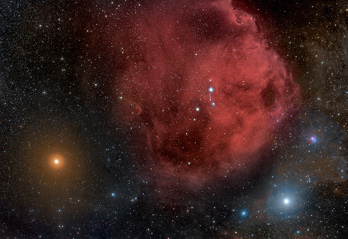Yesterday, the Universe just got a little bit more accessible: about 57% of the WISE mission’s infrared data of the sky has been released and can be searched online. Instructions on how to tap into that archive are available as well.
WISE mapped the entire sky in the infrared and found a treasure trove of fantastic objects (see Related Posts at the bottom of this post). As part of the news of this data release, NASA put up an image I hadn’t seen before, and it’s really amazing: the Lambda Orionis Nebula:
[Click to ennebulanate, but do it with care: the high-res version is a whopping 15,800 by 14,700 pixels and weighs in at 25 MB!]
It may look entirely alien, but you’ve probably seen this part of the sky before. See that blue star in the lower left? That’s Betelgeuse! Marking Orion’s shoulder, Betelgeuse is a red supergiant, destined one day to go supernova. It looks blue in this image because WISE sees in the infrared, and uses false colors. What’s colored blue in the image is actually light at a wavelength of 3.4 microns (the reddest light our eyes can see is about 0.7 microns). Cyan represents 4.6-microns, green is 12 microns, and red is 22 microns.
Betelgeuse puts out a lot of light in what we think of as red, but to WISE that’s actually a short wavelength, so the star looks blue in the picture. Green comes from organic long-chain molecules, while red is from warm dust. The star Bellatrix, Orion’s other shoulder, is the greenish star on the right. If you’re familiar with Orion, you’ll get the idea this picture covers a big region of the sky: hold your fist out arm’s length with your wrist line at Betelgeuse, and it will just about cover this image!
What you’re seeing is a thick, dense dust cloud. At the center is the star Lambda Orionis (the red one in the middle of the ring), a supergiant that, along with other massive stars, is warming up this vast cloud of material about 130 light years across.
 It looks a lot different in visible light. This shot here is from the supremely talented astrophotographer Rogelio Andreo, and is part of an enormous mosaic of Orion that is so tremendous I chose it as my top astronomy picture of 2010. I cropped it to roughly the same field of view, and you can see Betelgeuse, Bellatrix, and the nebula. The pink glow is from warm hydrogen, and that’s a sure sign of star formation. The dust ring in the WISE picture is on the outside of the hydrogen, where temperatures are somewhat cooler.
It looks a lot different in visible light. This shot here is from the supremely talented astrophotographer Rogelio Andreo, and is part of an enormous mosaic of Orion that is so tremendous I chose it as my top astronomy picture of 2010. I cropped it to roughly the same field of view, and you can see Betelgeuse, Bellatrix, and the nebula. The pink glow is from warm hydrogen, and that’s a sure sign of star formation. The dust ring in the WISE picture is on the outside of the hydrogen, where temperatures are somewhat cooler.
Look carefully at the visible light image: see the dark ring around the pink gas? That’s the dust ring seen by WISE! That dust strongly absorbs visible light, hiding the stars behind it. But in the infrared, where WISE sees, it glows brightly.
Remember, this is just a big bite of what WISE has seen, but is nowhere near all of it. Lurking in its data are millions of galaxies, untold nebulae, asteroids, comets, and much more. If you have a favorite object (I have hundreds) then take a look at the archive and see if they’re in there.
Related posts:
- Shocking star is shocking. Shocking, I say!
- In galactic collisions, might makes right
- A WISE view of a small neighbor
- Warm dusty rings around a weird binary star (probably my favorite WISE pic!)
- WISE finds the coolest stars. Literally.
- The seven WISE sisters
- A WISE flower blooms in space
- The first spectacular views of the sky from WISE
- WISE uncovers its first near-Earth asteroid!